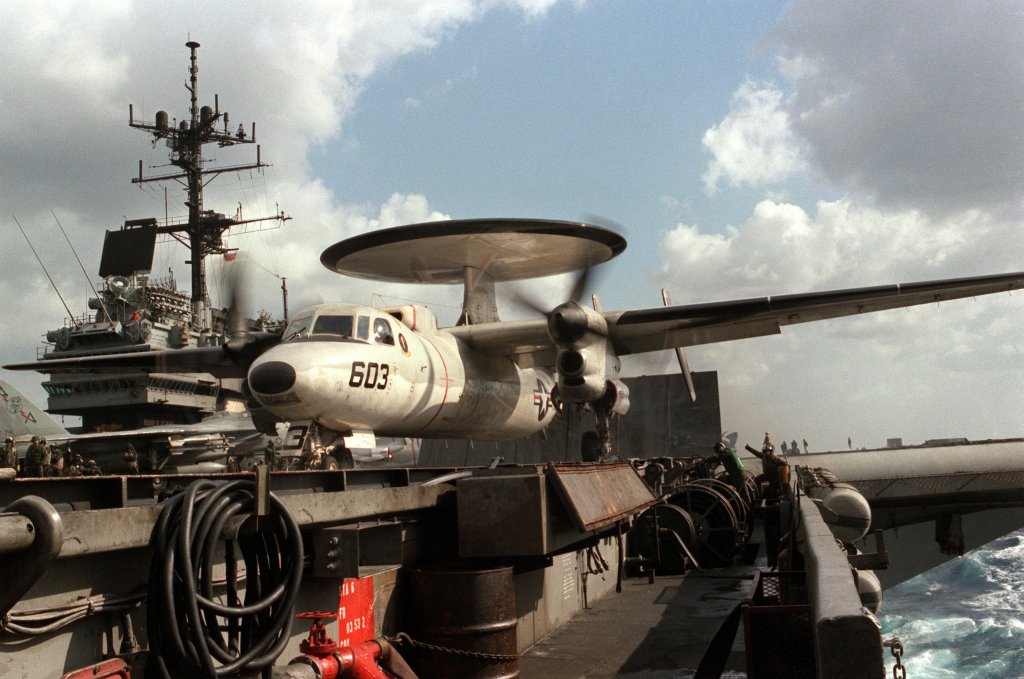‘Seriously – getting an E-2 “up” and in position for launch makes moving everything else around the flight deck more difficult,’ Andy Burns, US Navy Flight Officer with under 1500 hours in the Hawkeye
The all-weather E-2 Hawkeye was the US Navy’s first purpose-built Airborne Early Warning and battle management (AEW&BM) aircraft. The Hawkeye serves as the “eyes” of the US Navy fleet and continuous modifications and upgrades have kept the aircraft’s mission systems current with the evolving operational environment.
Nicknamed the “Hummer” for its distinctive engine sound, the Hawkeye’s prominent radar dish extends radar coverage for hundreds of miles.
Packed with a wide range of communications and sensor gear, the Hawkeye is truly a flying command center able not just to detect, track, and analyze targets but to share data with ships and aircraft in the battlegroup and coordinate weapons employment on dozens of platforms at once.
Usually, the Hawkeye is also the first aircraft to be launched from aircraft carriers at the beginning of day operations. Why?
‘Because the Handler and his minions hate having the E-2 moving around the flight deck. It’s big and bulky, with those two windmills of death just waiting for the unwary,’ says Andy Burns, US Navy Flight Officer with under 1500 hours in the Hawkeye, on Quora.
‘But seriously – getting an E-2 “up” and in position for launch makes moving everything else around the flight deck more difficult. Besides it’s sheer size, since it doesn’t have an Auxiliary Power Unit (APU), the E-2 needs to be supplied with external power until its onboard electrical generators (driven by the engines) are online, and there are only a few places on the flight deck with the necessary “deck edge power” connections.
‘The bow cats have those deck edge power connections nearby, so it’s just easiest to tow the E-2 there, getting it out of the way of all the other jets that need to be moved and “spotted,” before the next launch. When it’s time to start up for the next event, you get the Hummer started, spread, and launched first, and clear the deck for everyone else.
‘Of course, there’s always the risk that the plane will go “down” on the cat, and have to be pulled aft and one of the spare E-2s moved up for launch, in which case you can hear the Handler’s major arteries clanging shut across the ship.
‘So the E-2 is the first aircraft to be launched from carriers not “because the Hawkeye is the long-range eyes of the carrier group,” or to that effect. That’s not wrong, but it’s sort of obsolescent. That’s the Cold War answer, put it that way, when the E-2 had its original mission of defending the Battle Group against long-range Soviet aviation by detecting the bombers and guiding interceptors against them. Fleet air defense is still one of the E-2’s missions but it’s not a primary one anymore. In fact, the official designation for VAW squadrons was changed a couple of years ago, from “Carrier Airborne Early Warning” to “Airborne Command and Control.”’
Burns concludes;
‘The answer to the question of why the E-2 is always the first fixed-wing airborne on any given launch cycle, no matter what else is going on, is because it’s a pain in the ass to have it taxiing around the flight deck and makes it more difficult to move the other airplanes around. That’s really it.’
Photo by U.S. Navy


